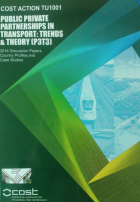
Social Sciences - Final Conference proceedings of COST A3 Action

Activity Report on the COST Ad Hoc Terminal Committee on Materials 1990-1993

Introduction to COST Cooperation - Sixth Edition (7 copies)

Pesticides - Soil - Environment, General Activity Report 1993-1995

European Conference on the Reversal of Multidrug Resistance from Bacteria to Cancer Cells and Parasites - Closing Conference of the COST Action B16
- Pages: 135 pages
- Author(s): Y. Becker
Proceedings of the European Conference on the Reversal of Multidrug Resistance from Bacteria to Cancer Cells and Parasites, which took place in Budapest, Hungary on 22-25 April 2006.

Studying Tree Responses to extreme Events
- Author(s): Achim Bräuning, Andreas Bolte, Cristina Nabais, Sergio Rossi and Ute Sass-Klaassen
- Publisher(s): Frontiers in Plant Science
- https://www.frontiersin.org/research-topics/4062/studying-tree-responses-to-extreme-events
Trees are among the longest-living organisms. They are sensitive to extreme climatic events and document the effects of environmental changes in form of structural modifications of their tissues. These modifications represent an integrated signal of complex biological responses enforced by the environment. For example, temporal change in stem increment integrates multiple information of tree performance, and wood anatomical traits may be altered by climatic extremes or environmental stress. Recent developments in preparative tools and computational image analysis enable to quantify changes in wood anatomical features, like vessel density or vessel size. Thus, impacts on their functioning can be related to climatic forcing factors.

Effects of Antinutrients on the Nutritional Value of Legume Diets vol 4
- Pages: 150
- Author(s): G. Bounous, A. de Guarda
- ISBN/ISSN: 978-92-827-9191-2
Lectins, inhibitors of digestive enzymes, tannins, phytates, ?-galactosides, antivitamins and many other low molecular weight components in foodstuffs are called antinutrients because they have a negative impact on the nutritional value of diets containing them. Legumes are a rich source of these compounds. However, with proper storage, heat treatment, soaking, germinating and cooking most of the antinutritional effects can be eliminated or substantially reduced.

Guanine Quartets. Structure and Applications
- Pages: 344
- Author(s): Edited by Wolfgang Fritzsche and Lea Spindler
- Publisher(s): RSC Publishing
- http://www.rsc.org/shop/books/2012/9781849734608.asp
- ISBN/ISSN: 978-1-84973-460-8
- EUR: 148
Guanosine and its derivatives have a high potential for self-recognition and self-assembly, as well as the recognition ability for other biologically important molecules. This book explores in detail these properties with the goal of increasing knowledge of the basic principles of guanosine-assembly, synthesis of new optimised materials and exploration of their electronic and optical properties.

Public Private Partnerships in Transport: Trends & Theory (P3T3)
- Pages: 318
- Author(s): Athena Roumboutsos, Sheila Farrell, Koen Verhoest (Eds.)
- Download from external website
COST Action TU1001 on Public Private Partnerships in Transport: Trends & Theory (P3T3) ends its Annual Discussion Papers with this volume offering in total 22 Country Profiles and 45 Case Studies encouraging cross-comparisons. Once again readers are challenged to answer the “why”, “what”, “who” and “which-way” issues of Public Private Partnerships in transport and wonder about their evolution.
